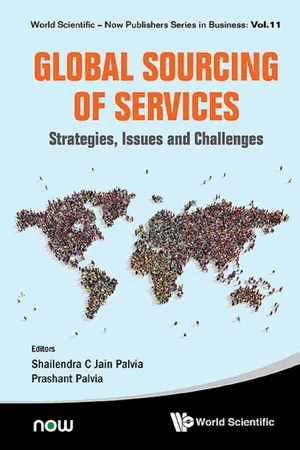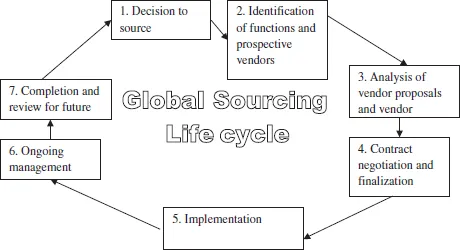![]()
Section III
Global Sourcing Life Cycle
![]()
Chapter 9
A Primer on Global Sourcing Life Cycle (GSLC)
Shailendra C. Jain Palvia
Long Island University Post, College of Management,
Brookville, NY 11548, USA
[email protected]
CHAPTER SUMMARY
Successful global sourcing requires a thorough understanding of the myriad of issues and challenges that both client and vendor companies have to navigate through. For a parsimonious comprehension of these issues, dividing hundreds (and sometimes thousands) of tasks that have to be executed from the conception of global sourcing as a corporate strategy to sustaining a successful ongoing relationship into few stages goes a long way. Towards this goal, both researchers and practitioners have divided global sourcing into 5–10 stages depending on the level of detail desired. This chapter breaks down global sourcing into seven stages: (i) decision to source; (ii) identifications of functions and prospective vendors; (iii) analysis of vendor proposals and vendor selection; (iv) contract negotiation and finalization; (v) implementation (vi) ongoing management; and (vii) completion and review for future.
Keywords: Global sourcing life cycle, client, vendor, decision to source, sourcing functions, vendor proposal, contract negotiation, implementation, ongoing management
INTRODUCTION
Global sourcing of services is a complex undertaking involving different languages, political philosophies, physical and telecommunications infrastructure, legal and regulatory regimes, and cultures. For similar such undertakings, practitioners have come up with the following structures to mitigate implicit risks.
•Systems development life cycle with primary phases of initiation, analysis, design, development, and implementation has been taught to MIS students and practiced by companies to create new information systems (IS) or computer applications for ongoing use.
•Product development life cycle (PDLC) with much touted phases of conception, design, prototyping, production (or discover, design, develop, deploy) helps product development team members on track by following a well thought out structure. To serve a customer from beginning to end, especially in the context of e-commerce, customer service life cycle is referred to by both practitioners and researchers.
•Customer service life cycle (CSLC) entails the phases of requirements, acquisition, ownership, and retirement/upgrading. It is increasingly used in the marketing function to optimize customer experience. In the requirements phase, the customer realizes that he/she needs a product or service and it is the advertising function of a company to engage the customer in this phase. Once engaged, in the acquisition phase, the customer orders, pays for, and acquires the product or service and it is the challenge for a company to make this happen as effortlessly and efficiently for the customer as possible (e.g., one click ordering on Amazon.com). In the ownership phase, customer owns the product or service and has to deal with training, repair, and maintenance, and it is for the selling company to keep the customer satisfied during this phase (e.g., online help by TurboTax to help its customers). Finally when the product gets old and obsolete, the customer is ready to purchase same or substitute product and it is the challenge for the original selling company to prevent the customer from moving to a competitor (e.g., Hyundai offers loyalty checks to its customers for being repeat customers of its cars).Organizations have to devise their marketing, promotional, pricing, product, and place strategies to maximize their effectiveness in these four phases.
The importance of a structure is all the more important given the complexities of modern day global sourcing arrangements. In global sourcing, options are numerous including vendor location options of onshore, nearshore, midshore, farshore; sourcing arrangement options of outsourcing, insourcing, or joint venture (JV); and having single or multiple vendors.
GLOBAL SOURCING LIFE CYCLE
There are several issues and challenges in different phases of the global sourcing life cycle as depicted in Fig. 1. Following are the details of these phases.
Fig. 1. Global sourcing life cycle.
Decision to Source
In this stage, a strategy to outsource — onshore, nearshore, or farshore — is articulated, reviewed and evaluated. It may be part of a larger business strategy for a company to reduce costs without compromising on quality and to focus on core competencies. Typically, the sourcing business strategy is developed at senior levels within a company. In this phase, company management will prepare a base case for sourcing one or more functions for short-term or long-term to one or multiple vendors or to one or multiple countries. While preparing a base case, it is imperative to understand and document the current approach to carrying out the function(s) in-house and compare current practices against industry standards and metrics while keeping age and size of your company in perspective. It must be clearly determined if the function(s) under consideration can be improved in-house or would be improved with outsourcing.
A vast majority of research articles have focused on the outsourcing decision by presenting various explanations of why organizations choose to outsource IS. Most view the outsourcing decision as a rational decision based on economic or resource-based factors. Goo et al. (2000) identified 14 theory-based drivers of outsourcing decision. However, cost savings was cited most commonly by a vast majority of researchers as the reason for outsourcing the IS function.
It is commonly assumed that an outside vendor can provide the same level of service at a lower cost than the internal IS department while the company can focus on its core competencies. Most research studies have focused on rational decision making based on transaction cost and resource-based theories. Alternative decision models based on institutional and political theories have been largely ignored. Ilie and Parikh (2004) confirm our belief that most studies have focused on the decision-making processes at large organizations. There is a need to investigate how the processes and decision drivers differ at smaller organizations. Furthermore, offshore outsourcing has been on a phenomenal rise since the beginning of the 21st century. Research prior to 2003 had focused primarily on onshore outsourcing.
Tiwana and Bush (2007) examined the relative importance that information technology (IT) managers ascribe to various factors from three complementary theories — transaction cost economics, agency theory, and knowledge-based theory — as they simultaneously consider them in their project outsourcing decisions. A secondary objective was to assess the cross-cultural robustness (U.S. versus Japan in this study) of such models in predicting project-level IT outsourcing decisions. The multi-theoretic model was tested using data on 1,008 project-level decisions collected from 33 Japanese and 55 U.S. managers. Decision to outsource can be based on thorough comprehension of potential rewards and risks of outsourcing.
Rewards of Outsourcing: The benefits of outsourcing can be summarized as follows (Saji, 2006):
•Cost Reduction — This applies mainly to offshore IT outsourcing owing to labor arbitrage, economies of scale and specialization;
•Quality — This is a result of Service Providers' IT capability, achieved through the integration of their human skills, IT infrastructure, reputation, etc.;
•Leveraging Time Zones — Work can be performed continuously 24×7, passing across different time zones of the globe;
•Higher capacity on demand;
•Access to advanced technologies;
•Opportunity to transform an organization through partnerships;
•Adoption of top level process management standards such as Software Engineering Institute’s (SEI) Capability Maturity Model (CMM), Capability Maturity Model Integration (CMMI); and ISO 9000. (For details of CMM, visit http://www.sei.cmu.edu/cmmi/) by outsourcing providers.
Risks of Outsourcing: However, the promising side of the IT outsourcing opportunity comes at a cost. IT outsourcing partnerships carry innate risk elements as evidenced by reported failures of such engagements in the recent past (Prewitt, 2001, 2004; Andersen, 2002). The sourcing of a function from outside a firm’s boundaries also results in the loss of control, flexibility, qualified personnel, and competitive advantage in Information Communications and Technology (ICT).
Outsourcing contracts carry risk owing to limited understanding about the future and bounded rationality of humans to analyze the past and the present. Therefore it is essential to understand the process involved in IT outsourcing decisions, the risk factors at each (Goo et al., 2000; Misra, 2004) phase of the decision process and measurement and management of the same at the time of contracting. Previous research has focused on identifying the variables involved in the outsourcing decision process at various levels and also the strategic risk dimensions involved in the process with a client focus (Gottfredson et al., 2005; Graf & Mudambi, 2005; Oh et al., 2006) examine stock market data to assess investors’ responses to various IT outsourcing risks due to the size of outsourcing contracts, difficulties in performance monitoring, asset specificity of IT resources, vendor capability, and the lack of cultural similarity between client and vendor firms. Aron et al. (2005) state that the risks associated with outsourcing, especially cross-border outsourcing, can be mitigated by the buyer by redesigning work flows and dividing work among multiple vendors. Peak et al. (2002) measured initial reaction in company stocks and listed options to outsourcing announcements by firms. They found that initially, large company IT outsourcing has a value-neutral but risk changing effect — but the firm value improves over time. Weak firms experience increased risk, while all other firms experience a reduction in risk.
Identification of Functions and Prospective Vendor(s)
This critical stage covers the definition of the work to be outsourced, identification of prospective vendors, Request for Information (RFI) and/or Request for Proposal (RFP) to the identified vendors, and defining the criteria for evaluation.
Identifying the functions to be outsourced is critical. The scope and scale of outsourcing has increased over the years. Depending on company size and age, outsourcing has proved beneficial for accounting, finance, human resources, legal marketing, and customer relationship management. A simple rule of thumb is that a company should consider outsourcing a function that has low strategic importance and high costs; otherwise, the company should consider retaining the function in-house or forming a strategic alliance. Four functions that are outsourced the most are: payroll, legal compliance, benefits administration, and background checks including drug screening. For example, besides reducing costs, companies consider outsourcing the recruiting function to improve speed of hiring and quality of hires; having access to scalable recruiting platform; complying with EEO and affirmative action laws and regulations; and developing metrics to monitor performance.
After identifying function, next step is RFI, a standard business process aimed at collecting critical information about few vendors pertaining to a prospective purchase of product(s) or service(s). It is a precursor to sending RFPs to selected vendors based on analyzing RFIs on some standard format.
RFP is a solicitation by a company to selected vendors to submit proposals to supply product(s) or service(s). RFP is a detailed document clearly stating what the vendor proposal should contain. For example an RFP for software outsourcing may include topics like purpose, background, description of problem to be addressed and work to be done, vendor credentials, software developer qualifications, expected schedule for project start and completion, terms and conditions, legal considerations, degree of reliance on written communication, format and length of proposal presentation, references, costs, proposal evaluation criteria, price stability.
Typically, for a large corporation, the proce...

